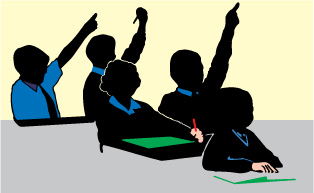There's a set of popular children's toys called Transformers. They do flips, slides and turns. Skateboarders enjoy doing flips, slides and turns, too. Here in California we have skateboard parks where you can watch kids of all ages trying out these moves and lots more. We call these moves by special names, and they follow agreed-upon rules, so all of us who modify a shape or make a move can do so in a repeatable fashion. Why bother? Because mathematicians (and people in general) like consistency.
Let's see what those words mean.
A slide or translation occurs when a figure moves without changing its appearance. It's as if you placed an object on an air hockey table up against the side wall of the table and slid it gently along the side of the table without flipping it over or letting it turn.
A turn or rotation occurs when a figure turns around a point. Imagine putting a paper fastener through a corner of this triangle and then pushing the fastener through a paper plate so the triangle is connected to the plate.
Now when you turn the triangle, the paper fastener holds the triangle in same place on the plate, while the shape rotates around that point:
We've given you a free Excel Math worksheet you can print out and use with your students to help them learn about flips, slides and turns. Click here for the PDF file you can download. The answers are given below.
 |
| Excel Math Grade 3 Lesson 120 Student Worksheet. Click here to download the PDF file. |
You may want to ask your students to watch for examples of flips, slides, and turns during the week and report back (or bring photos) with their findings. Point out that some of these transformations happen on the playground, in the classroom and at home on a regular basis.
If you have time, let your students demonstrate these definitions. In their own words, let them explain what each term (flip, slide and turn) means. When the definitions seem clear, play a game of "Flipped Out." Choose a volunteer to stand at the front of the room so he is sideways to the class. Have the student take one large step forward and turn around as he steps, so he's facing the opposite direction. Ask the class which transformation just took place. Some of your students may think this was a turn. Explain that a turn takes place around a point. Since the student took a step forward as he turned, this was a flip, not a turn. Have the students look at numbers 7-9 on their worksheet to see how the shapes are not moving around a point (as they are in numbers 13-15). Explain that to be more precise, you could have picked up the student and moved him into position, which might have been more obvious (but would not be appropriate in the classroom).
Ask another volunteer to stand facing the class and take a large step forward (have him slide his foot along the floor to make it more obvious). Ask the class which transformation this was. (slide)
Do the same with a different student but have him take a large step sideways. Have the students respond. (slide)
Have another student stand facing the class and spin around part way on one foot (ending with both feet on the ground). Have the students respond. (turn) Ask the students to tell you why this was a turn and not a flip. (He turned on one point—his foot.)
Continue in this manner, but tell the student quietly which term to demonstrate (or print the term on a slip of paper) and let the class guess what the student is doing. For a more competitive game, divide the class into two teams and give 100 points for each correct answer. To involve more students, have a separate student do the motions for each team and award points to the team that is first to guess correctly. For a card game version, cut apart numbers 10-21 on the worksheet and give the same card to each team (remove the instructions). Let the teams guess which term is being shown in the picture. The first team to have a player stand and call out the correct term wins the points.
Here are the answers to the student worksheet:
 |
| Excel Math Grade 3 Lesson 120 Student Worksheet Answers |
You may also like these articles:
Creating Electronic Math Flashcards
Thank You, Teachers!
May Day Math
Seven Steps to Successful Math Students (& Parents)















































